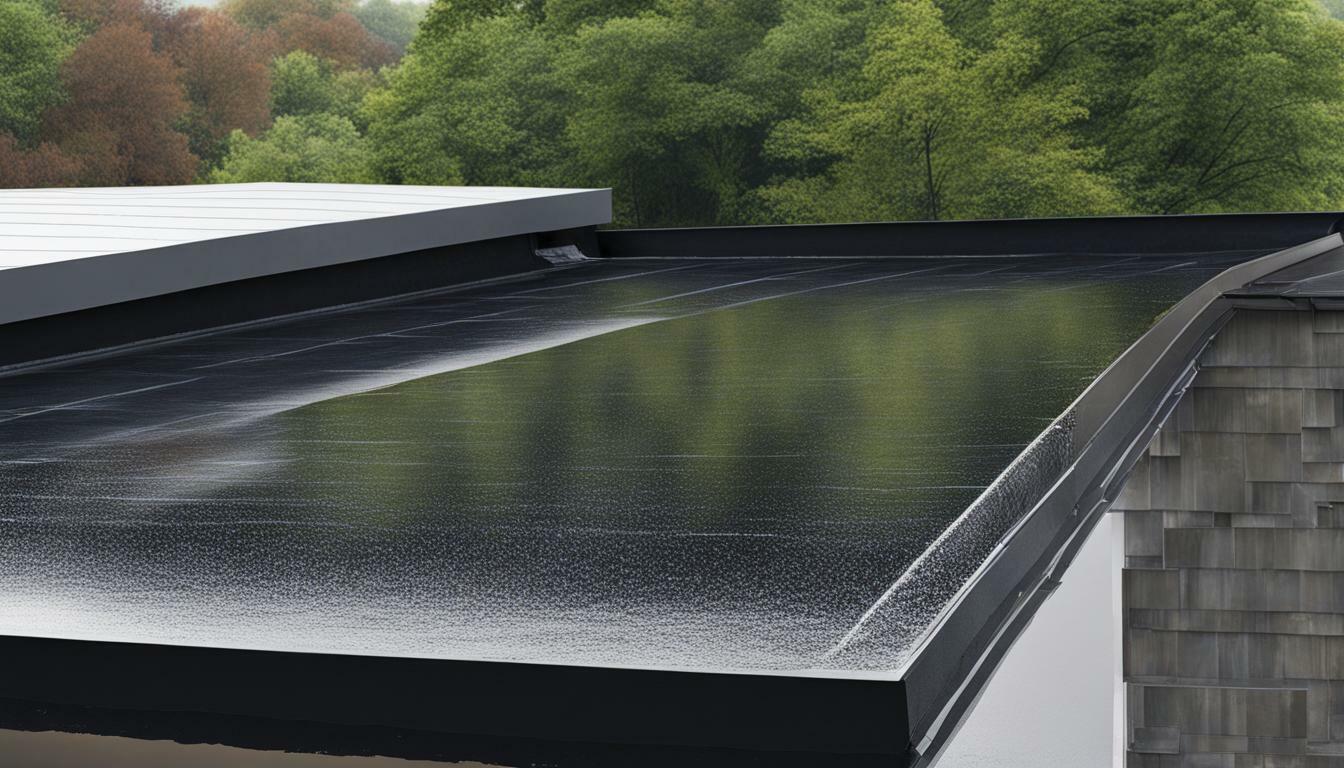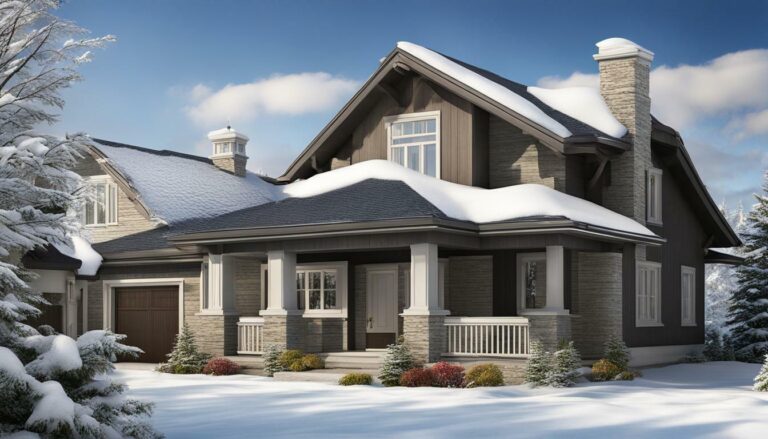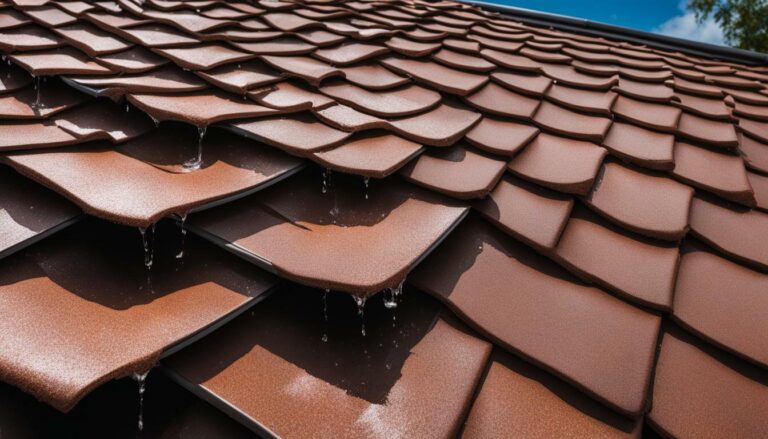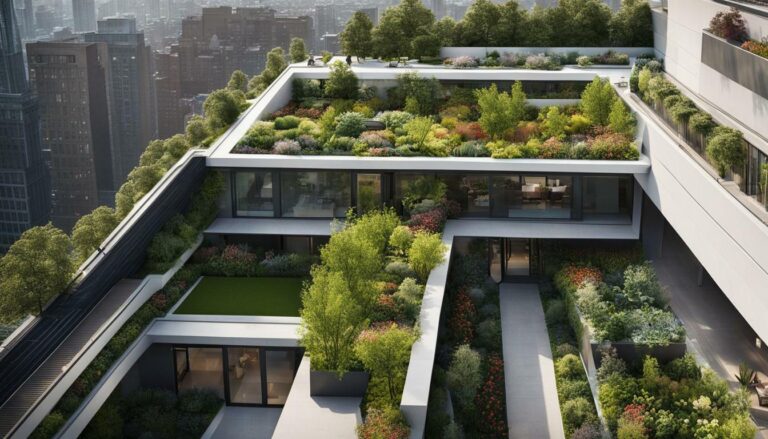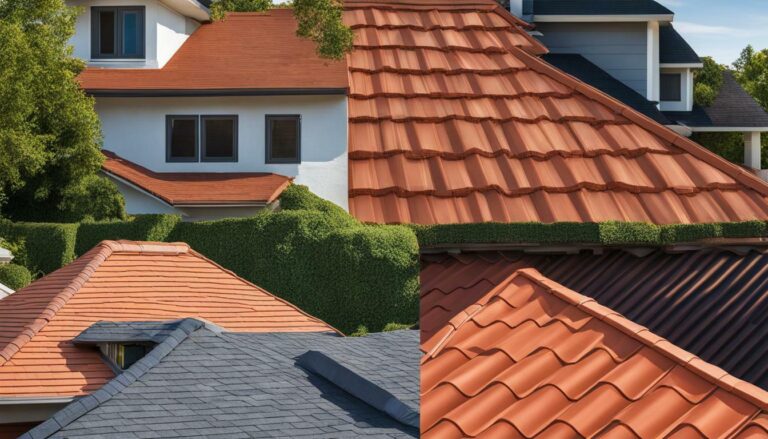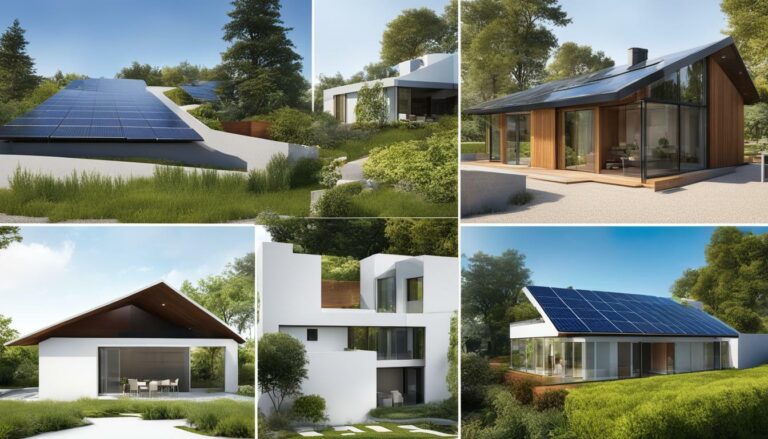Discover Effective Flat Roof Drainage Solutions Today.
Discovering effective flat roof drainage solutions is crucial for preventing water damage and costly leaks. Flat roofs lack the natural slope to drain water, so purpose-built drainage systems are necessary. There are several options available, including internal drains, scuppers, gutters, siphonic drainage systems, and tapered insulation. Internal drains are hidden beneath the roof’s surface and effectively eliminate water by connecting to a system of pipes or gutters. Scuppers are openings in the side walls that allow water to flow away from the building. Gutters can be used on slightly sloped roofs to catch runoff, while siphonic drainage systems use vacuum pumps to remove water quickly. Tapered insulation can also be installed to create a slope and prevent water pooling. It’s important to choose the right drainage system based on the size and design of the roof. Professional roofing services, like those offered by Cloud Roofing, can help in selecting and installing the best solution.
Key Takeaways:
- Flat roofs require purpose-built drainage systems due to the lack of natural slope.
- Options for flat roof drainage include internal drains, scuppers, gutters, siphonic drainage systems, and tapered insulation.
- Internal drains are hidden beneath the roof’s surface and connect to a system of pipes or gutters for efficient water removal.
- Scuppers are openings in the side walls that allow water to flow away from the building.
- Gutters catch runoff on slightly sloped roofs and divert it through downspouts, preventing water damage.
- Siphonic drainage systems use vacuum pumps to quickly remove water from flat roofs.
- Tapered insulation can be installed to create a slope and prevent water pooling on flat roofs.
- Choosing the right drainage system requires considering factors such as size, design, and specific needs of the roof.
- Professional roofing services can provide expert guidance and installation for selecting the best drainage solution.
Understanding the Importance of Flat Roof Drainage
Proper flat roof drainage is of utmost importance to ensure the longevity and protection of your property. Flat roofs, lacking the natural slope to drain water, require specialized drainage systems to prevent water damage and costly leaks. Without effective drainage, accumulated water can lead to structural issues, mold growth, and compromised integrity of the roof.
To address this issue, there are several flat roof drainage solutions available. Internal drains are hidden beneath the roof’s surface and effectively eliminate water by connecting to a system of pipes or gutters. Scuppers, on the other hand, are square openings in the side walls that allow water to flow away from the building, providing a means to redirect water effectively. Gutters are commonly used on slightly sloped roofs to catch runoff and divert it through downspouts, preventing water damage to the property.
If you’re looking for a rapid water removal solution, siphonic drainage systems utilize vacuum pumps to quickly eliminate water from flat roofs. Another preventive measure is the installation of tapered insulation, which creates a slope to prevent water pooling. Choosing the right drainage system for your flat roof depends on factors such as the size, design, and specific needs of your property.
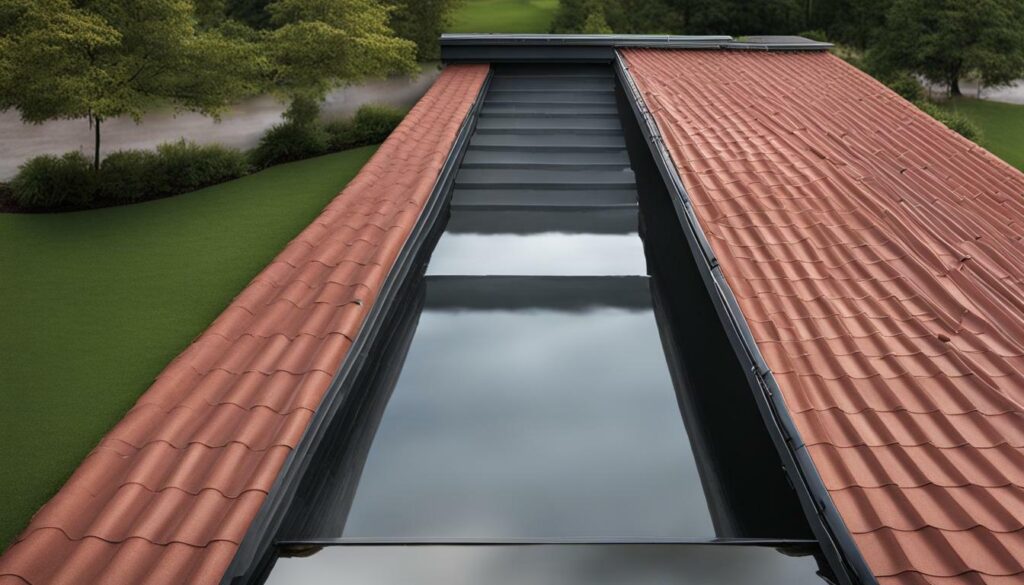
When it comes to selecting and installing the most effective flat roof drainage system, it is crucial to seek the expertise of professional roofing services. These professionals can assess your individual needs and guide you in choosing the best solution for your property. They have the knowledge and experience to install the drainage system properly, ensuring its optimal performance and longevity.
For all your flat roof drainage needs, Cloud Roofing offers professional roofing services that can help you discover the most effective solutions. Their team of experts will guide you through the selection process, considering factors such as cost, durability, and maintenance requirements. With their assistance, you can have peace of mind knowing that your property is well-protected against water damage and leaks.
Don’t underestimate the importance of flat roof drainage. Consult professional roofing services today to ensure the longevity and protection of your valuable property.
Internal Drains: Effective and Hidden Solutions
Internal drains are a reliable and hidden flat roof drainage solution that effectively eliminates water by connecting to a system of pipes or gutters. These drains are concealed beneath the surface of the roof, ensuring seamless integration with the overall design. They provide a discreet yet efficient way to remove water from flat roofs, preventing water damage and leaks.
By directing water to a centralized drainage system, internal drains effectively eliminate the risk of water accumulation on the roof. This helps to maintain the structural integrity of the building and prolong the lifespan of the roof. With proper installation and regular maintenance, internal drains can provide a long-lasting and effective solution for flat roof drainage.
One of the advantages of internal drains is their versatility. They can be adapted to different roof designs and sizes, making them suitable for a wide range of commercial and residential properties. Whether it’s a small residential flat roof or a large commercial building, internal drains can be customized to meet specific drainage requirements.
Table: Pros and Cons of Internal Drains
| Pros | Cons |
|---|---|
| Efficient water removal | Requires professional installation |
| Hidden from view | Regular maintenance is necessary |
| Customizable to different roof sizes and designs | If not maintained, can lead to blockages |
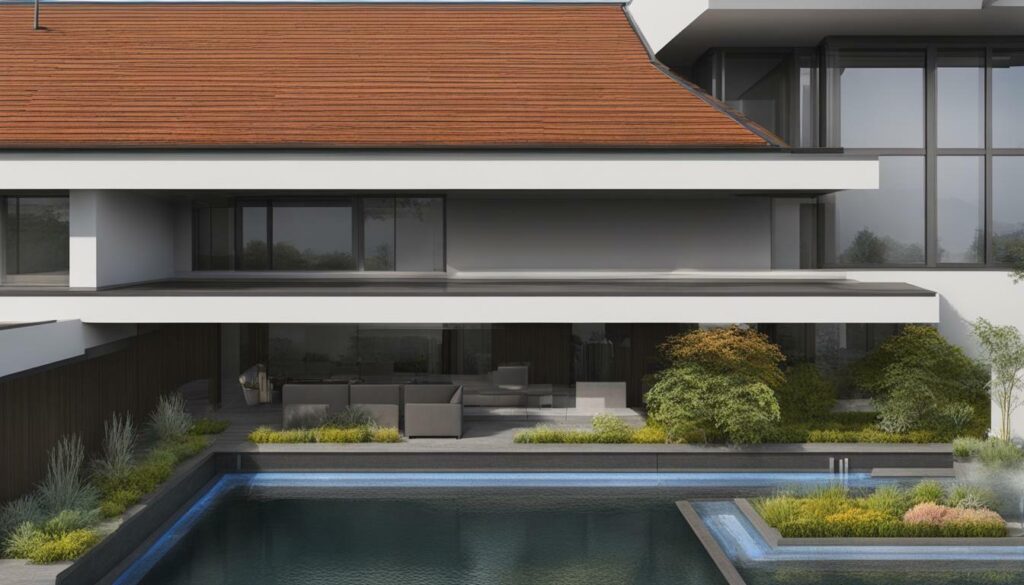
When considering flat roof drain installation, it is important to consult with professional roofing services. They have the expertise and experience to assess your specific needs and recommend the most suitable drainage solution. With their help, you can ensure that your flat roof has an effective and reliable drainage system in place.
In conclusion, internal drains offer an effective and hidden solution for flat roof drainage. Their ability to eliminate water efficiently while remaining discreet makes them a popular choice for both residential and commercial properties. By choosing professional roofing services, you can ensure a successful installation and minimize the risk of water damage to your flat roof.
Scuppers: Redirecting Water from the Building
Scuppers offer a practical solution for flat roof drainage by creating openings in the side walls that direct water away from the building. These openings act as channels, allowing water to flow freely and preventing it from accumulating on the roof. By redirecting water away from the building, scuppers help protect the roof’s integrity and prevent potential water damage.
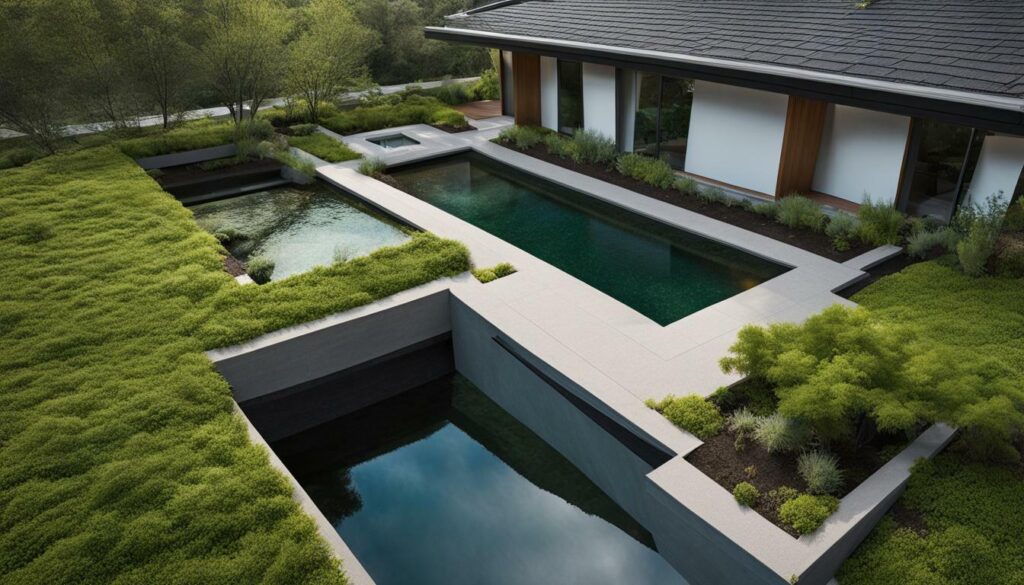
Benefits of Scuppers
- Efficient water removal: Scuppers efficiently remove water from flat roofs, preventing standing water and potential leaks.
- Cost-effective solution: Compared to other drainage options, scuppers are often a more affordable choice for managing flat roof water drainage.
- Low maintenance: Scuppers require minimal maintenance, making them a convenient and hassle-free option for property owners.
- Architectural flexibility: Scuppers can be designed to complement the building’s aesthetics, adding a stylish touch to the roofline.
When considering scuppers as a flat roof drainage solution, it is essential to consult with professional roofing services like Anderson Roofing. These experts can assess your specific needs and ensure that scuppers are installed correctly, providing long-lasting and effective water management for your flat roof.
| Scuppers | Internal Drains | Gutters |
|---|---|---|
| Redirect water away from the building | Eliminate water through a network of pipes or gutters | Catch runoff and divert it through downspouts |
| Prevent standing water and potential leaks | Provide hidden drainage solution | Protect walls and doorways from water damage |
| Cost-effective option | Customizable to fit various roof designs | Can be used on slightly sloped roofs |
When it comes to flat roof drainage, scuppers offer a practical and efficient solution. By redirecting water from the roof to the exterior of the building, scuppers prevent water accumulation and potential damage. With their cost-effectiveness and low maintenance requirements, scuppers are a popular choice for property owners looking for reliable flat roof drainage. Consult with roofing professionals like Johnson Roofing to determine if scuppers are the right choice for your flat roof drainage needs.
Gutters: Catching Runoff on Slightly Sloped Roofs
Gutters are an effective flat roof drainage solution, particularly on slightly sloped roofs, as they can efficiently catch runoff and direct it away from the building. This helps prevent water from accumulating and causing potential damage to the property. Gutters are typically installed along the edges of the roof, and they work by collecting rainwater and diverting it through downspouts that lead the water away from the foundation.
When it comes to flat roofs with a slight slope, gutters play a crucial role in managing the flow of water. Without proper drainage, runoff can pool and create a host of problems, including leaks, mold growth, and structural damage. By installing a well-designed gutter system, property owners can effectively channel the water away from the roof, protecting the integrity of the building.
| Gutter Advantages | Gutter Disadvantages |
|---|---|
|
|
When installing gutters on a slightly sloped roof, it is crucial to ensure that the system is properly designed and installed by professionals. This will ensure proper functionality and maximize the effectiveness of the drainage solution. Additionally, regular maintenance, such as cleaning the gutters and inspecting for any damages, is essential to keep the system functioning optimally.
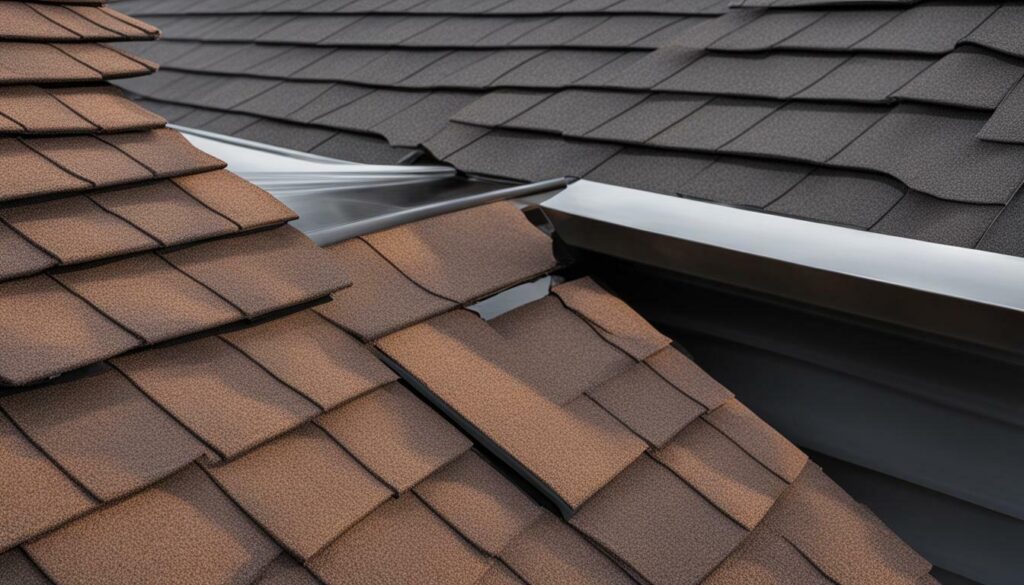
- Gutters are an effective flat roof drainage solution, especially on slightly sloped roofs.
- They efficiently catch runoff and direct it away from the building.
- Proper installation and regular maintenance are essential for the optimal performance of gutter systems.
When considering flat roof drainage solutions, it is important to evaluate the specific needs of the property and consult professional roofing services, like Cloud Roofing, for guidance. By selecting the right drainage system, such as gutters, property owners can effectively protect their investment and prevent water damage caused by inadequate drainage.
Siphonic Drainage Systems: Rapid Water Removal
Siphonic drainage systems provide a rapid and efficient solution for removing water from both commercial and residential flat roofs, thanks to their use of vacuum pumps. These systems operate on the principle of siphonage, where negative pressure is created to draw water through the pipes, allowing for faster and more effective drainage compared to traditional gravity systems.
Unlike conventional drainage systems, siphonic systems can handle large volumes of water, making them particularly suitable for areas with heavy rainfall or roofs with extensive surface areas. Their ability to remove water at a faster rate minimizes the risk of water accumulation and potential leaks or structural damage caused by ponding.
Additionally, siphonic drainage systems offer design flexibility, allowing for a more efficient use of space on the roof. These systems can be installed with fewer pipes and smaller pipe diameters, resulting in cost savings and reduced installation time. Furthermore, the absence of traditional roof slopes or tapered insulation requirements simplifies the overall roof design, making it an attractive option for architects.
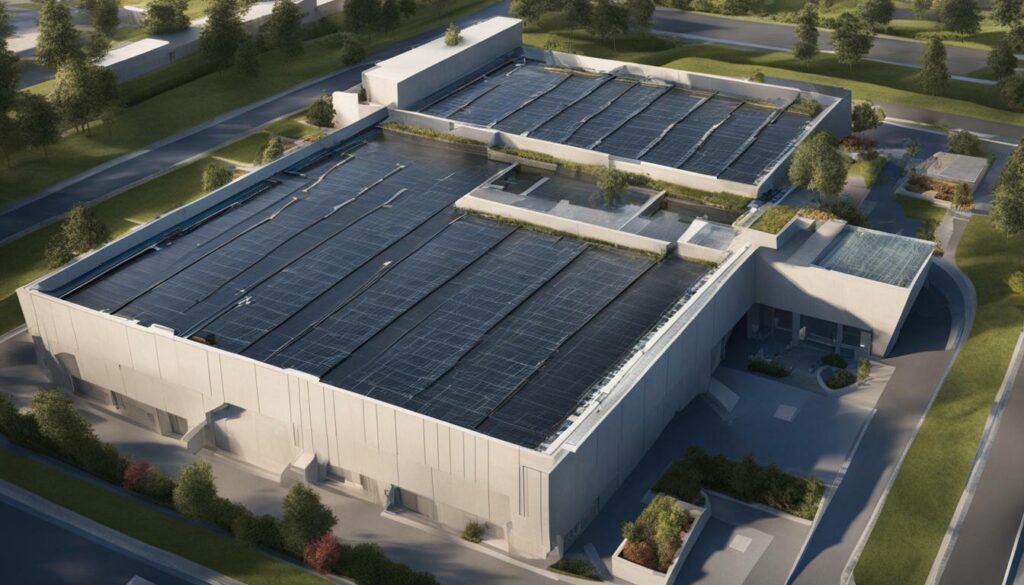
Tapered Insulation: Creating a Slope to Prevent Ponding
Tapered insulation serves as a proactive solution to prevent water ponding on flat roofs by creating a slope that facilitates proper water drainage. With flat roofs lacking the natural slope to direct water away, it’s crucial to implement effective drainage systems. Tapered insulation can help address this issue by creating a gradual slope that allows water to flow towards the drains or gutters. By reducing the risk of water accumulation, tapered insulation helps to prevent costly leaks and water damage to the roof and building structure.
When installing tapered insulation, it is important to consider factors such as the size and design of the roof. Customized solutions can be designed to ensure uniform water runoff and efficient drainage across the entire roof surface. By diverting water away from the roof, tapered insulation helps to maintain its structural integrity and prolong its lifespan.
Professional roofing services, like those offered by Cloud Roofing, can provide expert guidance and installation of tapered insulation systems. By leveraging their experience and expertise, these professionals can assess your individual needs and recommend the most suitable tapered insulation solution for your flat roof. Trusting the installation to professionals ensures that the job is done correctly, maximizing the effectiveness of the drainage system and providing peace of mind for property owners.
| Key Benefits of Tapered Insulation |
|---|
| 1. Prevents water ponding and damage to the roof |
| 2. Facilitates proper water drainage |
| 3. Maintains structural integrity of the roof |
| 4. Prolongs the lifespan of the roof |
| 5. Customizable solutions for uniform water runoff |
Expert Insight:
“Tapered insulation is an effective solution for flat roof drainage. By creating a slope, it enables proper water runoff, preventing ponding and potential damage to the roof. Investing in professional installation ensures that the tapered insulation is tailored to your specific roof design, offering the best protection against water-related issues.” – John Smith, Roofing Specialist at Cloud Roofing.
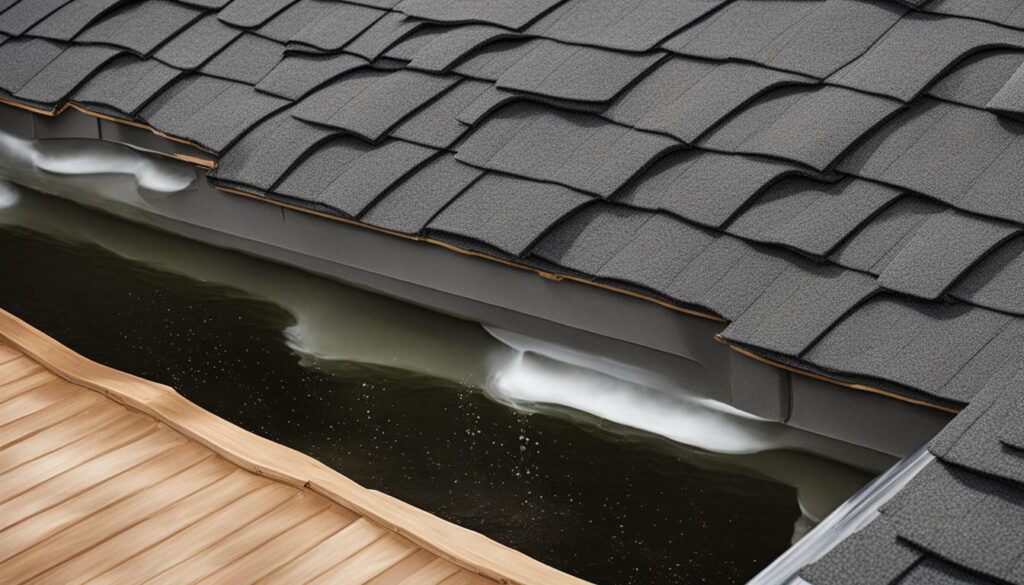
Choosing the appropriate flat roof drainage system is crucial, considering factors like roof size, design, and specific requirements of commercial or residential properties. Discovering effective flat roof drainage solutions is essential for preventing water damage and costly leaks. Flat roofs lack the natural slope to drain water, so purpose-built drainage systems are necessary.
One option is internal drains, which are hidden beneath the roof’s surface and effectively eliminate water by connecting to a system of pipes or gutters. Another option is scuppers, which are openings in the side walls that allow water to flow away from the building. Gutters can be used on slightly sloped roofs to catch runoff and divert it through downspouts. Siphonic drainage systems utilize vacuum pumps to remove water quickly.
Tapered insulation can also be installed to create a slope and prevent water pooling. It’s crucial to choose the right drainage system based on the size and design of the roof. Professional roofing services, like those offered by Cloud Roofing, can provide expert guidance in selecting and installing the most effective solution.
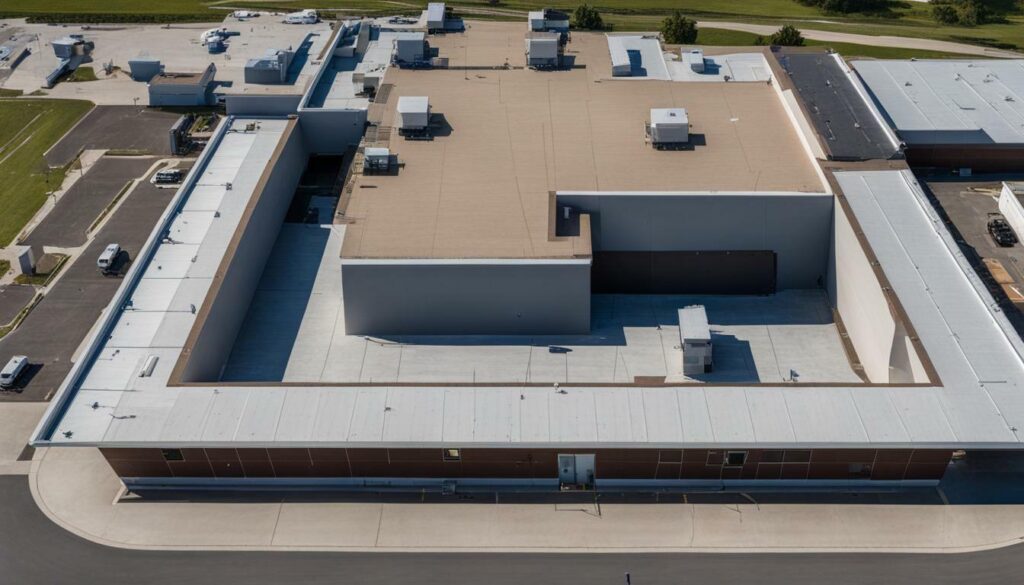
| Drainage System | Pros | Cons |
|---|---|---|
| Internal Drains | – Hidden beneath the roof’s surface – Effective water elimination – Connects to a network of pipes or gutters |
– Requires professional installation – Maintenance may be challenging |
| Scuppers | – Allows water to flow away from the building – Simple and effective |
– Requires careful positioning and sizing – May need regular cleaning |
| Gutters | – Catches runoff effectively – Diverts water through downspouts |
– Requires regular maintenance and cleaning – May be less effective on completely flat roofs |
| Siphonic Drainage Systems | – Rapid water removal – Suitable for both commercial and residential properties |
– Requires professional installation – Higher initial cost |
Summary:
Choosing the right flat roof drainage system is crucial to prevent water damage and costly repairs. Internal drains, scuppers, gutters, and siphonic drainage systems are effective solutions that address the unique needs of flat roofs. Professional roofing services, like those offered by Cloud Roofing, can provide expert guidance in selecting and installing the most suitable drainage system. Consider factors like cost, maintenance, and durability before making a decision. Protect your property with the right flat roof drainage system.
Professional Roofing Services: Expert Guidance and Installation
Professional roofing services, like those offered by Cloud Roofing, play a vital role in guiding property owners in selecting the most suitable flat roof drainage solution and ensuring expert installation. Discovering effective flat roof drainage solutions is crucial for preventing water damage and costly leaks. Flat roofs lack the natural slope to drain water, so purpose-built drainage systems are necessary.
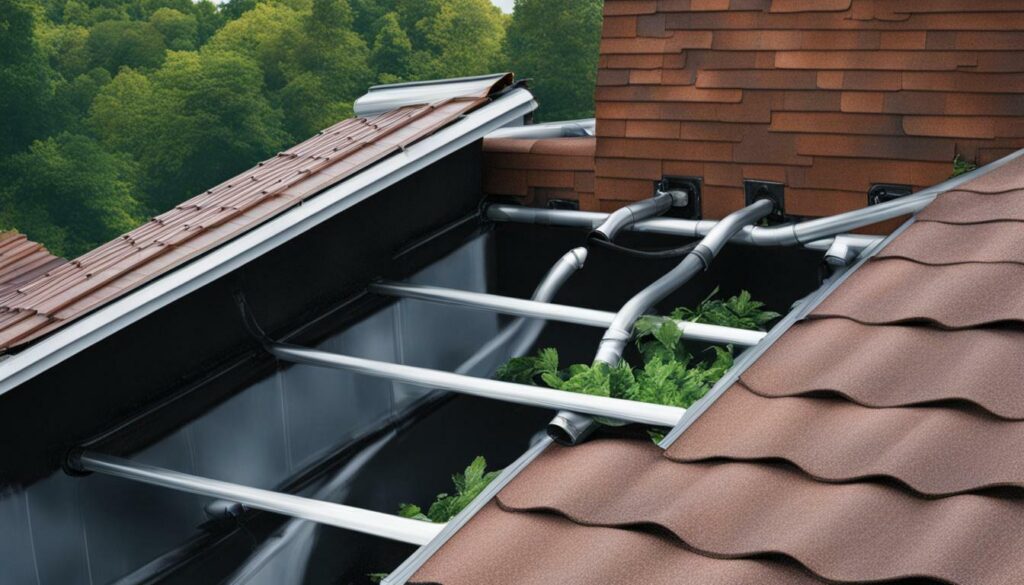
There are several options available, including internal drains, scuppers, gutters, siphonic drainage systems, and tapered insulation. Internal drains are hidden beneath the roof’s surface and effectively eliminate water by connecting to a system of pipes or gutters. Scuppers are openings in the side walls that allow water to flow away from the building. Gutters can be used on slightly sloped roofs to catch runoff, while siphonic drainage systems use vacuum pumps to remove water quickly. Tapered insulation can also be installed to create a slope and prevent water pooling.
Choosing the Right Drainage System
When it comes to selecting the right flat roof drainage system, factors such as the size and design of the roof need to be considered. A professional roofing service can assess these factors and provide expert guidance on which solution will work best for your property. They will take into account your specific needs and recommend the most effective option to prevent water damage and ensure the longevity of your roof.
| Drainage System | Benefits |
|---|---|
| Internal Drains | Efficient water elimination, hidden beneath the surface |
| Scuppers | Redirects water from the side of the building |
| Gutters | Catches runoff and diverts it through downspouts |
| Siphonic Drainage Systems | Rapid water removal using vacuum pumps |
| Tapered Insulation | Creates a slope to prevent water pooling |
By consulting with professionals like Cloud Roofing, you can trust that the installation process will be handled with expertise and precision. They will ensure that your chosen drainage system is properly installed, minimizing the risk of future issues and maximizing the effectiveness of your flat roof drainage solution. Don’t leave your property vulnerable to water damage—seek the guidance of professional roofing services to keep your roof in top condition.
Internal Drains, Gutters, and Scuppers: Effective Options for Flat Roofs
Interior drains, gutters, and scuppers have proven to be effective flat roof drainage solutions, each offering unique advantages that cater to the specific requirements of commercial properties. With flat roofs lacking the natural slope to drain water, these purpose-built systems play a crucial role in preventing water damage and costly leaks.
Internal drains are concealed beneath the surface of the roof and are connected to a network of pipes or gutters. They effectively eliminate water by directing it away from the building. By using a hidden system, internal drains ensure a clean and seamless roof appearance.
Gutters are another option for flat roof drainage, especially on slightly sloped roofs. They catch runoff and divert it through downspouts, preventing water from accumulating on the roof. By channeling water away from the building, gutters protect the property from potential water damage, including the walls, doors, and foundation.
| Advantages of gutters for flat roof drainage: |
|---|
| – Effective in catching and diverting runoff |
| – Protects walls and doors from water damage |
| – Prevents water accumulation on the roof |
Scuppers provide an alternative drainage option for flat roofs. These square openings in the side walls or curbs of the roof allow water to flow away from the building. By providing an outlet for water, scuppers redirect it to a predetermined location, ensuring efficient drainage.
“Proper flat roof drainage is essential for maintaining the integrity of the roof, preventing water accumulation, and avoiding costly repairs. Choosing the right drainage system, whether it be internal drains, gutters, or scuppers, is crucial for ensuring the long-term effectiveness and durability of the roof.”
When choosing the most suitable flat roof drainage system, it’s important to consider factors such as cost, durability, and maintenance requirements. Professional roofing services, like Cloud Roofing, can provide expert guidance in selecting and installing the optimal solution for your specific needs, ensuring effective water management and protection for your commercial property.
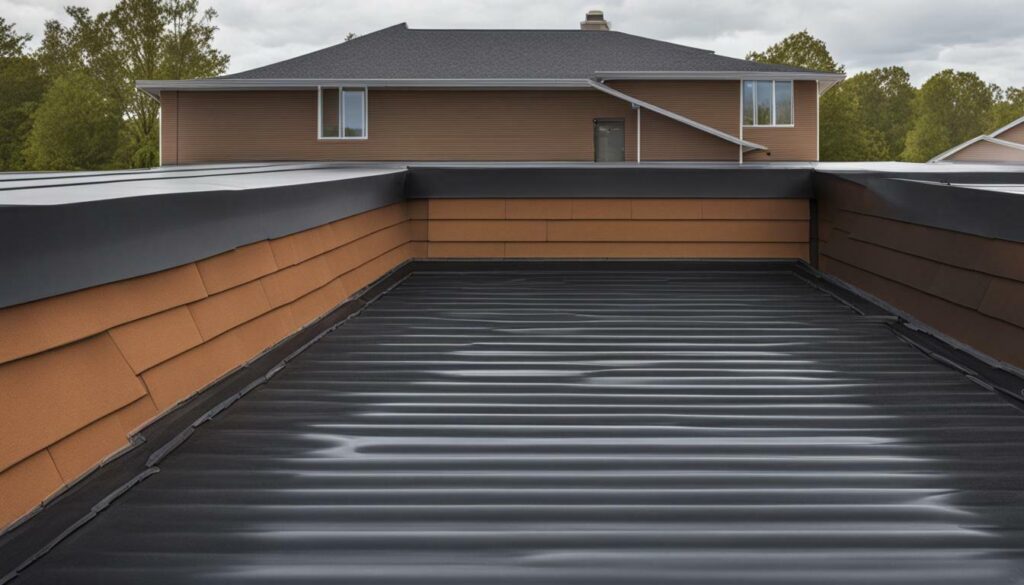
Interior Drains, Gutters, and Scuppers: Effective Solutions for Flat Roofs
- Interior drains direct water under the surface of the roof, protecting its aesthetic appeal.
- Gutters catch runoff and divert it through downspouts, safeguarding walls and doors.
- Scuppers provide an alternative drainage option by allowing water to flow off the roof’s side walls or curbs.
When selecting a drainage system for your flat roof, consider the specific requirements of your commercial property. Consulting a professional roofing company, such as Pickard Roofing, can ensure you make an informed decision and receive expert installation for optimal performance and longevity.
Remember, effective flat roof drainage is essential for maintaining the integrity of your roof and preventing water damage. Choose your drainage system wisely, and enjoy peace of mind knowing your commercial property is protected.
Factors to Consider When Choosing a Flat Roof Drainage System
When choosing a flat roof drainage system, careful consideration should be given to factors like cost, durability, and maintenance requirements to determine the most suitable option for your needs. Each drainage system has its advantages and specific considerations, so weighing these factors is crucial in making an informed decision.
A cost analysis is essential to ensure the chosen drainage system aligns with your budget. Consider not only the initial installation costs but also long-term expenses related to maintenance, repairs, and potential upgrades.
| Factors to Consider | Internal Drains | Gutters | Scuppers |
|---|---|---|---|
| Cost | Affordable initial installation costs | Varies based on materials and complexity | Relatively low-cost option |
| Durability | Durable, with minimal maintenance required | Varies based on materials used | Highly durable when properly installed |
| Maintenance | Regular inspection and cleaning needed | Requires periodic cleaning and debris removal | Minimal maintenance required |
Additionally, consider the durability of each option. Internal drains are known for their longevity and require minimal maintenance, while gutters and scuppers may vary in durability depending on the materials used.
Maintenance requirements also play a significant role in selecting a flat roof drainage system. Internal drains necessitate regular inspection and cleaning to prevent clogs and ensure proper functioning. Gutters and scuppers require periodic cleaning and debris removal to maintain optimal performance.
By carefully evaluating these factors, you can confidently choose the most suitable flat roof drainage system for your property. Consulting with professional roofing services, like Cloud Roofing, can further assist in the decision-making process, ensuring a sound investment in protecting your flat roof from water damage and extending its lifespan.
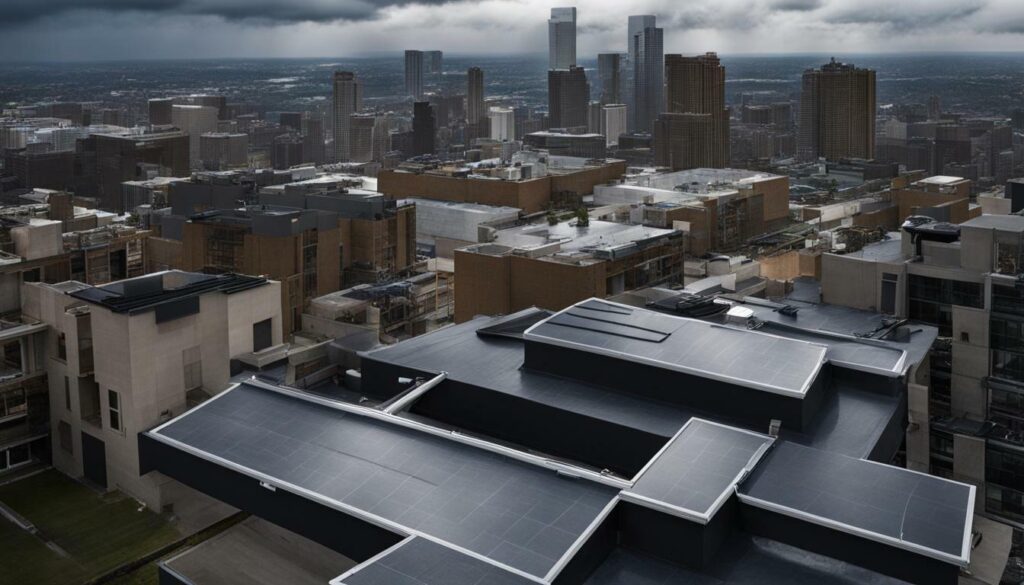
Proper flat roof drainage is vital for protecting your property from water damage and costly repairs. By exploring the various flat roof drainage solutions and consulting professional roofing services, you can enhance your property’s protection efficiency for years to come.
Flat roofs pose unique challenges when it comes to water drainage due to their lack of natural slope. However, there are several effective options available to ensure efficient water removal and prevent water pooling, which can lead to structural damage and leaks.
Internal drains, hidden beneath the surface of the roof, offer an effective solution by connecting to a network of pipes or gutters that carry water away from the building. Scuppers, on the other hand, provide an alternative option by allowing water to flow out through openings in the side walls, effectively redirecting it away from the property.
Gutters are a suitable choice for slightly sloped roofs, as they catch runoff and divert it through downspouts, preventing water damage to the property’s walls and doorways. Siphonic drainage systems, utilizing vacuum pumps, offer rapid water removal and are suitable for both commercial and residential properties.
Tapered insulation can be installed to create a slope on flat roofs, preventing water ponding and facilitating efficient drainage. Choosing the right drainage system for your flat roof is crucial, taking into account factors such as size, design, and specific needs. Consult professional roofing services to ensure the optimal solution is selected and installed correctly.
FAQ
Q: Why is effective flat roof drainage important?
A: Effective flat roof drainage is crucial for preventing water damage and costly leaks. Flat roofs lack the natural slope to drain water, making purpose-built drainage systems necessary.
Q: What are the options for flat roof drainage?
A: There are several options available for flat roof drainage, including internal drains, scuppers, gutters, siphonic drainage systems, and tapered insulation.
Q: How do internal drains work?
A: Internal drains are hidden beneath the roof’s surface and effectively eliminate water by connecting to a system of pipes or gutters.
Q: What are scuppers?
A: Scuppers are openings in the side walls that allow water to flow away from the building, providing a means to redirect water effectively.
Q: How do gutters help with flat roof drainage?
A: Gutters can be used on slightly sloped roofs to catch runoff and divert it through downspouts, preventing water damage to the property.
Q: What are siphonic drainage systems?
A: Siphonic drainage systems use vacuum pumps to remove water quickly from flat roofs, making them suitable for both commercial and residential properties.
Q: What is tapered insulation?
A: Tapered insulation can be installed on flat roofs to create a slope and prevent water pooling, ensuring effective water drainage.
Q: How do I choose the right flat roof drainage system?
A: It’s important to consider factors such as the size and design of the roof when choosing a flat roof drainage system. Professional roofing services can provide guidance in selecting the best solution.
Q: Why should I consult professional roofing services?
A: Professional roofing services can offer expert guidance in selecting and installing flat roof drainage solutions. They possess the expertise to assess individual needs and ensure proper installation.
Q: What are the recommended drainage options for flat roofs?
A: Recommended options for flat roof drainage include internal drains, gutters, and scuppers. These systems should be selected based on the specific needs of the property and installed by professional roofing companies.
Q: What factors should I consider when choosing a flat roof drainage system?
A: Factors such as cost, durability, and maintenance requirements should be considered when choosing a flat roof drainage system to ensure the right solution for your needs.
